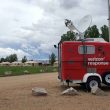Laboratory tested
Let’s first consider a conventional Hertz antenna. The antenna must be 25% of the wavelength for the “hot side” radiator, and another 25% for the ground side of the antenna. At 4 MHz, this translates to approximately 120 feet of space needed for the antenna radiator. In addition, the antenna must be above ground by at least 25% of a wavelength, which means that a 60-foot or taller tower must be part of the antenna system. The size of the antenna follows the formula:
Wavelength (feet) = 468/frequency (MHz)
A conventional Hertz antenna develops the electric (E) and magnetic (H) fields 90 degrees apart in time. These fields are very large and interact with close objects, including the ground. In contrast, the EH antenna’s unique design ensures that the E and H fields develop simultaneously and are in phase.
Moreover, the EH antenna’s instantaneous bandwidth is larger than the conventional quarter or half wavelength antenna that it replaces. This means that the antenna does not have to be retuned as the channels are changed in the same band, and that wider bandwidth modulation schemes will work properly with this type of antenna. In addition, objects that are in close proximity to the EH antenna do not detune the antenna and seriously degrade the signal path, as occurs with a conventional antenna.
A test laboratory was constructed that covered three distinct ranges: 40 meters, 60 meters and 75 meters. Conventional dipole antennas, a vertical antenna and an EH antenna were deployed in the same location within 200 feet of each other. The results were as follows.
Setup: The three dipole antennas, vertical antenna, and EH antenna were terminated into a 5-position antenna switch, then through a standing wave ratio (SWR) meter, then into an ICOM Model IC720A multimode HF transceiver. The S-meter on the transceiver was calibrated using a commercial model IFR1200S communications service monitor, so that each S-unit was translated into an exact dBm reading.
Measurements were made during daylight hours and repeated into the night. The 40-meter signals during the day mainly followed an NVIS path, meaning that the received signals bounced off the ionosphere almost directly above the receive site. This translates to signals on the horizontally polarized dipoles that would be 20 dB to 40 dB stronger than those of the vertically polarized dipole. The 60-meter signals were coming in at a much lower angle, and were consistent between the vertical and the horizontal. The 75-meter signals were not present during the daylight hours, but were present at night. The directivity of the dipoles factored into the readings, as well as the angle of the signal coming into the different antennas. These matched known theory of antenna patterns previously published in numerous books and articles.
Bandwidth: A measurement was made on each antenna as to how broad the antenna was when tuned, and the SWR was below the 1.5:1 level.
Band-change speed:Regarding the vertical antenna and the EH antenna, the time required for the antennas to achieve resonance was noted. A second transmission was made to see whether the antennas remembered the previous settings; the tuner immediately returned to the previous settings.
Signals:The signals between the dipoles and the EH antenna were within 3 to 6 dB of each other, as long as the angles were within the range of the dipole radiation angles. In directions were the dipole would have a null pattern, the EH antenna’s performance was significantly superior, and more than 20 dB stronger, than the dipole antennas. The vertical antenna did not work well during the daylight hours due to the null pattern. Meanwhile, the dipoles and the EH antennas were far superior to the vertical antenna during the daylight hours, but the vertical antenna did start performing once the paths came from a lower angle.
Noise: The EH antenna had a much lower noise floor than the other antennas by a factor of 10 to 20 dB.
Changing frequencies in the same band: As long as the signals were inside of the frequencies to which the dipoles were tuned, the signals were comparable to each other. When signals were received outside the tuned frequency and bandwidth for the dipoles, the dipoles’ efficiency dropped dramatically, from -10 dB to -30 dB each. Meanwhile, the EH antenna generated superior signals throughout the tuned range of the antenna, which was from 3.5 MHz to 11.0 MHz.
Changing bands: As the bands were changed, the EH antenna’s automatic tuner activated, as evidenced by the current being drawn from the power supply (approximately 3 amps), the noise from the antenna tuner and the reduction of standing wave ratio, as measured by the SWR meter. The tuner was able to go from one band to another in less than 20 seconds on the first transmission on a given band.
Propagation: The EH antenna has a spherical antenna pattern. Imagine an antenna pattern like a globe or ball. Some of the other characteristics of the EH antenna include the fact that the antenna works the same whether it is 3 feet or 300 feet above ground level; it is not disturbed by metal objects or structures more than 3 feet from the antenna; and its SWR is below 1.5:1 over the entire range of the antenna, from 3.5 MHz to 11.0 MHz









